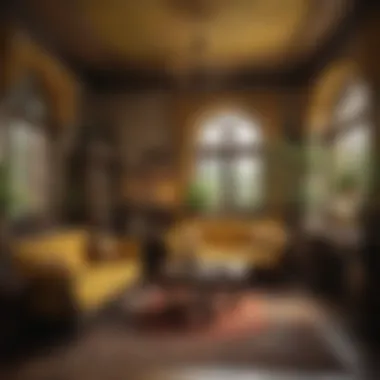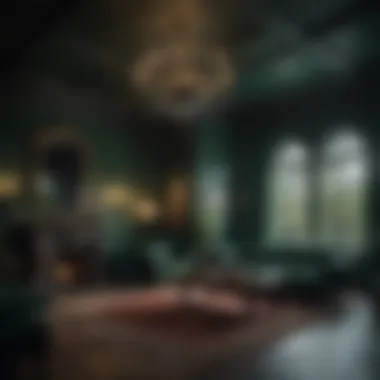Understanding Your Hogwarts House Identity


Intro
The Hogwarts house system introduced in J.K. Rowling's Harry Potter series serves as a fascinating lens through which to examine identity. Each house – Gryffindor, Hufflepuff, Ravenclaw, and Slytherin – represents distinct values, traits, and traditions. Understanding your house identity does not just provide insight into your character; it also reflects broader themes in personality psychology and social dynamics within the wizarding world. This article seeks to unravel these complex layers, catering to those who wish to explore their place in this iconic universe, as well as the implications of house affiliation in real life.
News Updates
As the Harry Potter franchise continues to thrive, various developments draw attention to the Hogwarts house system's cultural significance. Recent announcements about spin-off series and stage plays indicate an ongoing interest in exploring the magical world. The addition of interactive experiences at theme parks also sparks discussions about how individuals engage with their house identity.
Furthermore, activities surrounding the Wizarding World franchise often highlight how fans express their house pride. This cultural enthusiasm contributes to the relevance of understanding one’s Hogwarts house, considering the emotional connections established among fans.
House Attributes and Identity
Each of the four houses embodies unique traits that define their members.
- Gryffindor is known for bravery and courage. House members often value adventure and loyalty. This house encourages individuals to face challenges head-on, motivating them to take risks for the greater good.
- Hufflepuff emphasizes hard work and dedication. Members are often seen as kind-hearted and inclusive, fostering a sense of community. This house attracts those who prioritize teamwork and fairness.
- Ravenclaw represents intelligence and wisdom. Individuals sorted here often value knowledge and creativity, highlighting the importance of learning and critical thinking.
- Slytherin focuses on ambition and resourcefulness. House members typically share a drive to succeed, often possessing strong leadership qualities and strategic thinking skills.
Understanding these attributes enables individuals to reflect on their own personality traits and how they align with specific houses.
Psychological Implications
The sorting into houses can have profound psychological implications. It often serves as a way for individuals to categorize their identities in a manner that promotes belonging and acceptance. Research into social identity theory suggests that belonging to a particular group can increase self-esteem and enhance feelings of security among its members.
The psychological impacts of house affiliation extend beyond fantasy. They shape interpersonal relationships and community dynamics in real-world settings.
Cultural Significance
The Harry Potter series has transcended entertainment, becoming a significant cultural touchstone. The house system plays a crucial role in this phenomenon, influencing various aspects of popular culture. Discussions about Hogwarts houses often occur in educational settings, online forums, and social media platforms. This engagement fosters dialogue about personality traits and moral values, encouraging readers to consider the deeper meanings behind the categorization of identity.
Prelude to Hogwarts Houses
Understanding the concept of Hogwarts houses is vital for grasping one's identity within the Harry Potter universe. This section provides a foundation for the exploration of house traits, values, and their significance in personality development. The houses serve as a lens through which individuals can reflect on their unique characteristics and social dynamics. By analyzing the essence of each house, readers can foster a deeper connection to the world of magic and friendship.
Overview of the Hogwarts School of Witchcraft and Wizardry
Hogwarts School of Witchcraft and Wizardry is a magical institution that provides education to young witches and wizards. Founded over a millennium ago, this school is split into four distinct houses: Gryffindor, Hufflepuff, Ravenclaw, and Slytherin. Each house has its own founding values shaped by the qualities of its creator. The emblematic colors and crests evoke a sense of belonging and pride among house members.
The school itself is vast, with specific places like the Great Hall and the Forbidden Forest. Each area contributes to the rich tapestry of Hogwarts life. Students participate in various subjects such as Potions, Defense Against the Dark Arts, and Transfiguration. Furthermore, inter-house competitions like the Quidditch Cup and the House Cup foster camaraderie and rivalry alike. The yearly Sorting Ceremony is the pivotal moment when students discover their house affiliation, which plays a crucial role in their development and interactions within the school.
Significance of House Affiliation
House affiliation profoundly affects students throughout their Hogwarts journey. It shapes their perspectives, friendships, and behavioral patterns. Each house embodies specific qualities.
For instance, Gryffindor is known for bravery, while Hufflepuff exemplifies loyalty. Ravenclaw champions intelligence and creativity, and Slytherin encourages ambition and resourcefulness. Recognizing these traits helps students to connect with others who share similar values.
Moreover, house identity extends beyond Hogwarts into the wider wizarding world. Many adult wizards and witches align themselves with particular houses, impacting their choices and life’s paths. Discussions about house characteristics evoke passions and debates, illustrating the strong emotional ties linked to this identity.
On a psychological level, the Sorting Hat process encourages self-reflection. It challenges students to consider their qualities and beliefs. Thus, house affiliation undoubtedly plays a pivotal role in shaping not only one's school experiences but also their self-understanding and societal interactions.
The Four Hogwarts Houses
The concept of the four Hogwarts houses is essential in understanding one's identity within the Harry Potter universe. Each house represents distinct values and traits that shape the experiences of its members at Hogwarts School of Witchcraft and Wizardry. By examining these attributes, readers gain insights into their own personal characteristics and how they relate to the broader social dynamics within the magical community.


The sorting into these houses is not merely a matter of allegiance; it influences friendships, rivalries, and even one's career path. It is critical to understand these nuances to appreciate the full impact of house identity.
Gryffindor: The Courageous
Founding and Values
Gryffindor was founded by Godric Gryffindor, known for his bravery and daring. The values of this house center around courage, determination, and chivalry. Gryffindors tend to act on their principles and often face challenges head-on. The house emblem, a lion, symbolizes strength and valor. Such characteristics are often celebrated in literature and media, resonating with audiences who admire courage and fearless leadership. This emphasis on bravery makes Gryffindor a popular choice among many individuals drawn to heroic narratives.
Key Traits of Gryffindor Students
Students belonging to Gryffindor exhibit key traits such as boldness, confidence, and a strong sense of justice. They often take risks and stand up for what they believe is right. This tendency to challenge the status quo can lead to significant personal growth and development. However, the impulsive nature of Gryffindors may sometimes put them in precarious situations. This mix of bravery and recklessness defines the unique experience of Gryffindor students.
Notable Gryffindors
Famous characters like Harry Potter, Hermione Granger, and Ron Weasley exemplify Gryffindor traits. Their journeys highlight the importance of friendship and bravery in overcoming adversities. Such examples serve to inspire readers and fans, providing relatable figures who embody the house's values. Yet, being consistently under pressure and scrutiny is a challenging aspect that members of Gryffindor must navigate.
Hufflepuff: The Loyal
Founding and Values
Founded by Helga Hufflepuff, this house stands for loyalty, patience, and hard work. Hufflepuff values inclusiveness and equality, making it a home for those who may not fit into the more flashy icons of other houses. The emblem of the badger reflects these qualities, representing a steadfast and hardworking nature. Such value systems encourage personal integrity and ethical behavior, making Hufflepuff a favorable choice for those who prioritize community over individual accolades.
Key Traits of Hufflepuff Students
Hufflepuff students are often characterized by their reliability, kindness, and a strong sense of fair play. They may not always seek the spotlight, but their contributions are foundational to the success of group endeavors. This house promotes collaboration and steadfastness; however, the underestimation of Hufflepuffs can create challenges in gaining recognition for their efforts. Understanding these traits enriches the narratives surrounding loyalty and teamwork.
Notable Hufflepuffs
Prominent figures like Cedric Diggory and Newt Scamander illustrate Hufflepuff's diverse talents. Their stories convey the importance of resilience and dedication, highlighting how these traits lead to success over time. While their path may seem quieter compared to Gryffindors, their impact is significant. Members of Hufflepuff may face the struggle of being overlooked, but they often find fulfillment in their supportive roles.
Ravenclaw: The Intelligent
Founding and Values
Ravenclaw was founded by rowena ravenclaw, who valued intelligence, wit, and wisdom. The house promotes a love for learning and the pursuit of knowledge, making it ideal for those who thrive in academic settings. The eagle as its emblem represents high aspirations and a keen intellect. This focus on education and intellectual growth is advantageous in helping students become critical thinkers, enriching the academic environment at Hogwarts.
Key Traits of Ravenclaw Students
Ravenclaw students are known for their creativity, intelligence, and curiosity. They often approach problems analytically and enjoy challenging conventional wisdom. This pursuit of intellectual growth can lead to personal achievements and discoveries. However, an intense focus on studies may sometimes result in social isolation. Thus, balance is key in the journey of a Ravenclaw.
Notable Ravenclaws
Renowned individuals such as Luna Lovegood and Filius Flitwick embody Ravenclaw attributes. Their unique perspectives and magical prowess shine through in various critical situations. Their stories highlight how intellectual pursuits can lead to great accomplishments. Nonetheless, the pressures of academic excellence can weigh heavily on them, emphasizing the complexities of their identity.
Slytherin: The Ambitious
Founding and Values
Slytherin, founded by Salazar Slytherin, celebrates ambition, cunning, and resourcefulness. The house values power and success, often appealing to those who are driven by goals and aspirations. The serpent emblem symbolizes keen intelligence and strategic thinking. Understanding these foundations is crucial for recognizing how ambition can both empower and challenge its bearer in the context of house identity.
Key Traits of Slytherin Students


Students sorted into Slytherin often exhibit traits such as determination, ambition, and a practical mindset. They excel in leadership roles and often navigate complex social structures with ease. However, this focus on ambition may sometimes lead to unethical behavior as individuals prioritize personal gain over collective benefit. These complexities make Slytherin a house of duality, embodying both positive and negative connotations.
Notable Slytherins
Noteworthy characters like Severus Snape and Tom Riddle reveal the variegated nature of Slytherin identity. Their stories demonstrate the potent mix of ambition and moral struggle that haunts many within this house. These examples shed light on the broader implications of ambition, challenging readers to consider how this trait can lead to varied life paths. The complexity of Slytherin relationships often requires careful navigation due to ingrained biases against the house.
The Sorting Hat: Mechanisms and Mystique
The Sorting Hat serves as a critical element within the framework of Hogwarts identity. It embodies both the mystical and psychological dimensions of how students are categorized into their respective Hogwarts houses. Understanding its function can provide insight into the broader themes of identity within the Harry Potter series. This section will delve into its history, how it operates in practice, and the implications of personal choice in the sorting process.
History of the Sorting Hat
The origin of the Sorting Hat is steeped in the rich history of Hogwarts School of Witchcraft and Wizardry. Created from the magical materials of Godric Gryffindor's old hat, it combines sorcery and tradition. After the founding of the school by the four esteemed witches and wizards—Gryffindor, Hufflepuff, Ravenclaw, and Slytherin—the Hat was enchanted to sort students based on their predominant traits and values.
The Hat's ability to read minds and discern the motivations of young witches and wizards is remarkable. It has undergone changes throughout the ages, becoming a symbol of the school itself. Understanding this history can deepen one's appreciation for the Hat's role in discerning Hogwarts identity.
Sorting Process Explained
The sorting process is characterized by its unique blend of ceremony and individuality. During the Sorting Ceremony, the Hat interacts with each student as they sit upon the stool. A substantial part of the sorting procedure hinges on the interplay between the Hat's decisions and the student's subconscious inclinations.
When students are placed under the Hat, it communicates with their inner thoughts.
- Gryffindor students often feel courage and valor.
- Hufflepuff candidates may reflect strong loyalties and fairness.
- Ravenclaw seekers demonstrate a thirst for knowledge.
- Slytherin aspirants reveal ambition and cunning.
These traits guide the Hat's final decisions, ensuring that each student ends up in a house where they can thrive. This process highlights the importance of not just inherent traits but the choices made during formative years.
Influence of Personal Choice
Personal choice plays a significant role in the sorting process. While the hat has an extraordinary capacity to read minds, it ultimately respects the student's preferences. This aspect makes the sorting experience deeply personal. It posits that while characteristics and traits might suggest a certain house, the desires of the individual can sway the Hat's final decision.
In many ways, this illustrates a fundamental tenet of identity: the balance between inherent traits and conscious choices. Individuals may align with multiple house values, suggesting that Hogwarts identity is not fixed but rather fluid.
"It is our choices that show what we truly are, far more than our abilities."
— J.K. Rowling, with this quote, encapsulates the essence of self-discovery within the sorting experience.
Self-Assessment Methods
Understanding one's Hogwarts house is not just an exercise in fandom; it has deeper implications for personal identity. Self-assessment methods provide a means to explore personal values, characteristics, and preferences. These methods serve as a bridge, connecting one's self-perception to the broader context of their chosen house. Engaging with self-assessment methods can offer several benefits including greater self-awareness, clarity in personal values, and insight into relationships with others.
Self-assessment helps individuals articulate their unique traits. The process encourages reflection on past experiences and future aspirations. By analyzing these aspects, one can better understand their aligned house's traits.
Personality Quizzes and Tests
The use of personality quizzes has gained popularity in discerning Hogwarts identities. These quizzes often measure traits aligned with each house's characteristics, like bravery for Gryffindor or cunning for Slytherin. They are designed to highlight latent personality aspects that individuals may or may not recognize.
- Types of Quizzes: Common quizzes can be found on platforms like Pottermore or other dedicated Harry Potter websites. They typically ask questions about preferences, reactions to different situations, and even hypothetical dilemmas.
- Accuracy and Interpretation: While the accuracy of these quizzes can vary, they often provide a fun and engaging way to explore house identification. However, consider the results as a guide rather than a definitive classification. Just as each wizard is unique, so too are the interpretations of their results.
Reflection and Self-Analysis
Beyond quizzes, self-reflection is a critical tool for understanding one’s Hogwarts identity. This method encourages deep thought about personal experiences, values, and motivations that might not be captured in a quiz. Reflecting on life events can unearth qualities reminiscent of the houses.
- Questions to Consider: Engage with questions like:
- Journaling Practice: Keeping a journal can aid this process. Regular entries about daily occurrences, reactions, and newfound insights may reveal patterns indicating house traits.


- "What actions felt most fulfilling in my life?"
- "How do I react in high-pressure situations?"
- "What do I value in my friendships?"
In summary, self-assessment through quizzes and reflective practices enriches the understanding of one's place within the Hogwarts house system. It offers a comprehensive perspective on how personal characteristics align with the foundational principles of each house.
Cultural Impact of Hogwarts Houses
The significance of Hogwarts houses transcends the boundaries of the Harry Potter series. They have become a vital part of popular culture, reflecting societal values, personal identity, and community dynamics. This section explores the cultural impact of these fictional factions, addressing their relevance in contemporary society and how they resonate across different demographics.
Houses in Popular Culture
Hogwarts houses have found their way into various cultural sectors, influencing media, fashion, and social interaction. They serve as a shorthand for personality traits and behaviors, often used in discussions about character development in movies and literature. For instance, Gryffindor symbolizes bravery, while Ravenclaw represents wisdom. This classification simplifies complex human traits, facilitating an instant understanding among fans.
Movies such as Fabulous Beasts and numerous fan films utilize house identity as a crucial aspect of character arcs. The popularity also extends to merchandise, with clothing, accessories, and home décor showcasing house logos. Such items create a sense of belonging among fans, nurturing a community unified by shared interests in their respective houses.
Additionally, the concept of houses appears in various adaptations, including video games like Hogwarts Legacy. Players are sorted into houses, reinforcing the narrative's core principles while enhancing engagement with the source material. This illustrates how the houses maintain relevance in modern storytelling, aligning with the values of both new and long-time fans.
Influence on Fan Communities
The impact of Hogwarts houses on fan communities is significant. Online forums, social media groups, and fan conventions foster discussions centered around house identity. Fans often express their affinity for their chosen houses through posts, art, and storytelling. This rich engagement highlights how house affiliation shapes self-perception and social interactions.
"Hogwarts houses not only define fictional characters but also help individuals navigate their own identities in the real world."
The communities inspired by these identities lead to collaborations among fans, resulting in fan fiction, art, and even cosplay. Collaborations often emphasize the strengths and weaknesses of each house, stimulating dialogues on values like loyalty, ambition, and intelligence. Such discussions allow fans dissect their understanding of the deeper themes presented in the series.
Participating in house-related events fosters camaraderie and promotes inclusion. Social gatherings and online meetups provide opportunities for fans to connect. These interactions solidify bonds based on shared experiences and house dynamics, demonstrating how fictional affiliations cultivate real-world friendships.
Understanding the cultural impact of Hogwarts houses reveals essential insights into how individuals relate to narratives and themselves. The classifications offer more than just fun; they provide frameworks for understanding personality and social dynamics in both fictional worlds and reality.
Implications of House Affiliation
The classification into one of the four Hogwarts houses carries significant implications for a person's identity and experiences. Understanding these implications can aid in comprehending one's behaviors, aspirations, and social interactions. Being sorted into a house is not just a matter of categorization; it reflects intrinsic values and influences life approaches.
Personal Identity and Self-Perception
Being sorted into a Hogwarts house can profoundly affect personal identity and self-perception. Each house embodies distinct characteristics and ideals that members often internalize. This houses' identity often shape individual beliefs and behavior. For example, Gryffindors are often seen as brave and daring, which leads them to engage in activities that challenge their limits. Conversely, Slytherins might focus more on ambition and resourcefulness, influencing their career choices and social strategies.
Moreover, the idea of belonging to a house can create a strong sense of community. Members often find pride in their house identity, reinforcing their self-image. They may adopt the traits associated with their house, integrating these qualities into their daily lives.
This process emphasizes the power of group identity shaped by institutional labels. Assessing one's house can facilitate a deeper understanding of personal motivations and social interactions.
Impact on Social Dynamics
House affiliation significantly impacts social dynamics within various environments. In Hogwarts, the houses foster a sense of rivalry and camaraderie. This can lead to competition between houses, as seen during the Quidditch Cup and other events. Such dynamics nurture friendships but also create friction. This often extends beyond the wizarding world into fan communities and discussions outside the books and films. Many enthusiast engage in debates about the merits of each house, further heating the social atmosphere surrounding these classifications.
On a broader scale, house identity can influence interpersonal relationships in various settings, such as workplace or social gatherings. For instance, individuals may gravitate toward peers from their house, establishing connections based on shared values. These connections are sometimes visible through social media platforms like Facebook or Reddit, where communities thrive around house affiliations.
Culmination
Summary of Findings
Throughout our exploration, we identified key points regarding each Hogwarts house. Gryffindor embodies courage and bravery, while Hufflepuff is a symbol of loyalty and hard work. Ravenclaw showcases the value of intelligence and creativity, whereas Slytherin emphasizes ambition and resourcefulness. Each house possesses distinct traits that resonate deeply with personal identity.
Additionally, we touched upon methods for self-assessment. Personality quizzes and self-reflection provide valuable insight into one’s inclinations and preferences. The Sorting Hat process also plays a crucial role, blending a student’s choices with innate characteristics. Such insights reinforce the importance of house identity as not only a part of Harry Potter lore but also a tool for self-discovery.
Final Thoughts on House Identity
Understanding one’s Hogwarts house identity goes beyond the confines of the Wizarding World. It offers a lens through which individuals can better understand their attributes and how these relate to larger social structures. The implications of house affiliation can manifest in personal relationships, career choices, and even community engagement. Recognizing and embracing these traits fosters a sense of belonging and community among peers. As fans of the series, acknowledging our houses allows us to celebrate diversity in intellect, ambition, loyalty, and courage, defining our unique contributions to the world.
In summary, your house identity is a key aspect of your individual narrative. Look beyond the surface and reflect on what your Hogwarts house says about you. Engaging with this identity enriches the overall experience within the Harry Potter universe and supports personal growth, making it a meaningful pursuit for any fan.







